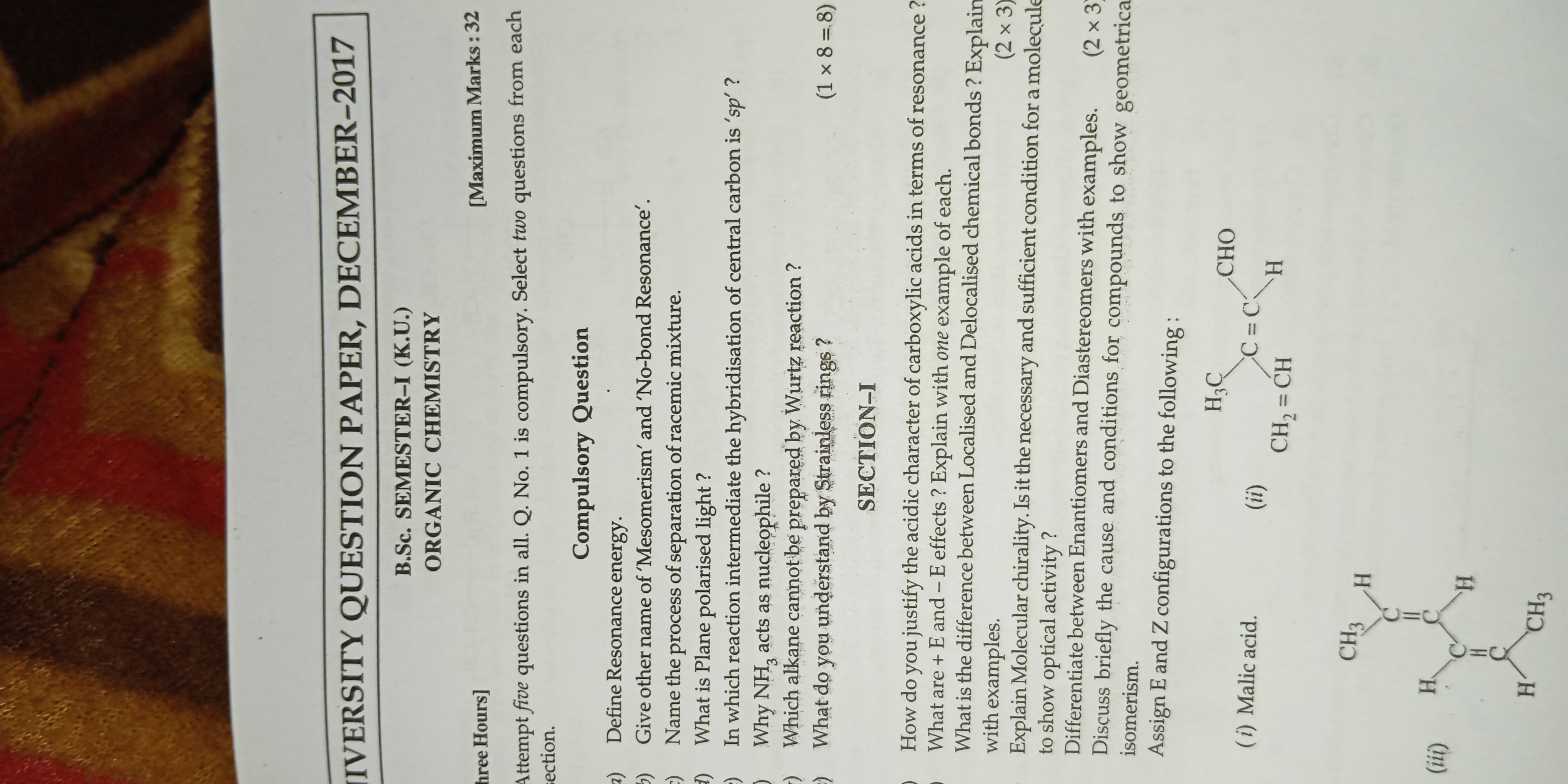Define resonance energy. Give the name of mesomerism and no-bond resonance. Name the process of separation of racemic mixture. What is plane polarised light? In which reaction inte... Define resonance energy. Give the name of mesomerism and no-bond resonance. Name the process of separation of racemic mixture. What is plane polarised light? In which reaction intermediate does nucleophile act? Why NH4 acts as nucleophile? Which alkane cannot be prepared by Wurtz reaction? What do you understand by structural isomerism? How do you justify the acidic character of carboxylic acids? What are the End - E effects? Explain with one example of each. What is the difference between localised and delocalised bonds? Assign E and Z configurations to the following: Malic acid.

Understand the Problem
The question appears to be from an organic chemistry exam paper, asking students to define key concepts, describe chemical reactions, and assign configurations to specific compounds in organic chemistry.
Answer
Resonance energy: energy difference in forms; Mesomerism: resonance type; Racemic separation by crystallization; Plane polarized light: single plane light; NH3 as nucleophile; Methane in Wurtz reaction; Structural isomerism: same formula, different structure; Carboxylic acids are acidic due to resonance.
- Resonance energy: Difference in energy between the actual molecule and most stable resonance form.
- Mesomerism/No-bond resonance: Same as resonance.
- Racemic mixture separation: Often resolved by crystallization or chiral chromatography.
- Plane polarized light: Light waves in a single plane.
- Nucleophile reaction intermediate: Acts in SN1/E1 reactions.
- NH3 as nucleophile: Donates lone pair for reaction.
- Alkane and Wurtz reaction: Methane cannot be prepared.
- Structural isomerism: Molecules with same formula but different constitution.
- Acidic character of carboxylic acids: Due to resonance stabilization of conjugate base.
- Endo/Exo effects: Refers to stereochemical outcomes in reactions.
- Localized/Delocalized bonds: Localized are confined between two atoms, delocalized are spread over several atoms.
- E/Z configurations of Malic acid: Determined by priority of substituents on the double bond.
Answer for screen readers
- Resonance energy: Difference in energy between the actual molecule and most stable resonance form.
- Mesomerism/No-bond resonance: Same as resonance.
- Racemic mixture separation: Often resolved by crystallization or chiral chromatography.
- Plane polarized light: Light waves in a single plane.
- Nucleophile reaction intermediate: Acts in SN1/E1 reactions.
- NH3 as nucleophile: Donates lone pair for reaction.
- Alkane and Wurtz reaction: Methane cannot be prepared.
- Structural isomerism: Molecules with same formula but different constitution.
- Acidic character of carboxylic acids: Due to resonance stabilization of conjugate base.
- Endo/Exo effects: Refers to stereochemical outcomes in reactions.
- Localized/Delocalized bonds: Localized are confined between two atoms, delocalized are spread over several atoms.
- E/Z configurations of Malic acid: Determined by priority of substituents on the double bond.
More Information
Resonance energy shows stability of actual structure compared to possible forms. Plane polarized light is crucial for optical activity studies. Methane can't form via Wurtz due to instability of required radicals.
Tips
Confusing mesomerism with other electronic effects like hyperconjugation. Misidentifying E/Z configuration without proper priority rules.
Sources
- Resonance - Chemistry LibreTexts - chem.libretexts.org
- Resonance Effect & Explanation with Examples - Chemistry - BYJU'S - byjus.com
- Chirality, Racemisation and Optical activity of Haloalkanes - BYJU'S - byjus.com
AI-generated content may contain errors. Please verify critical information